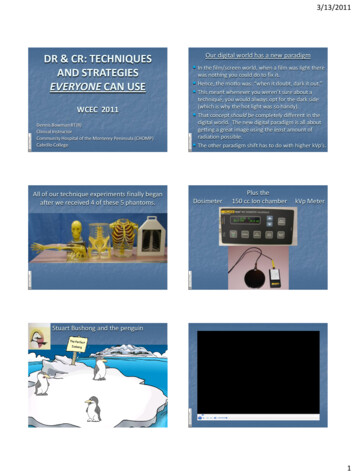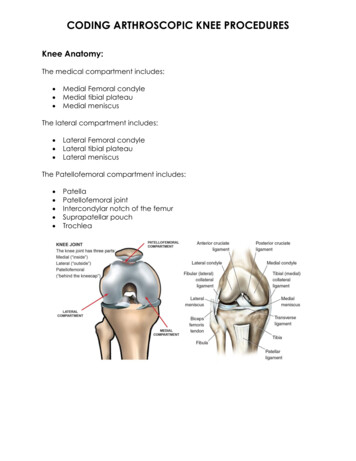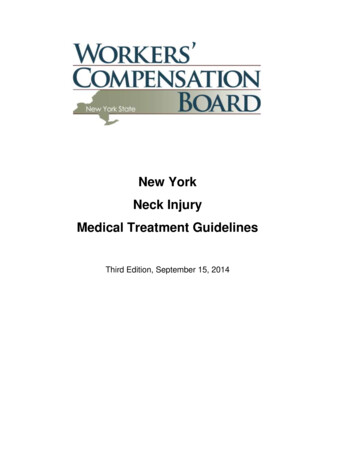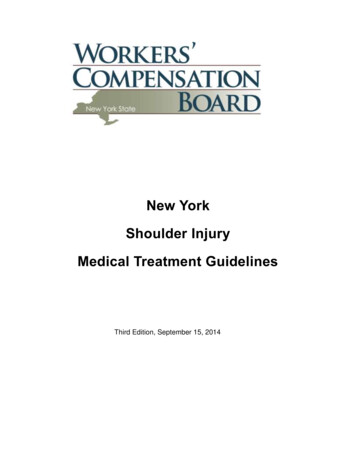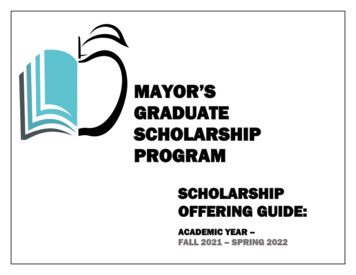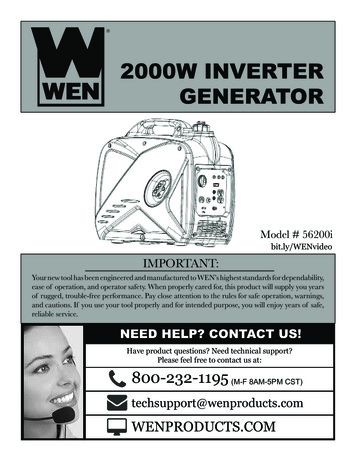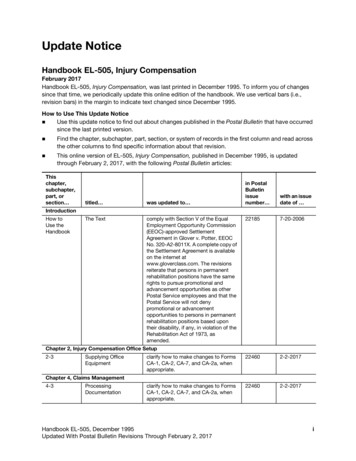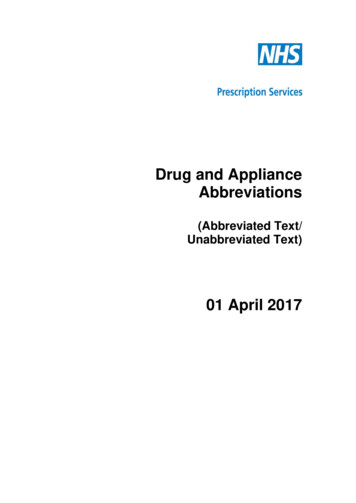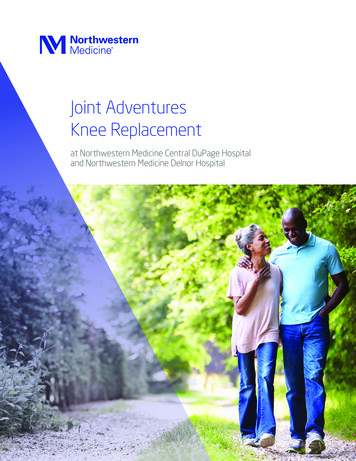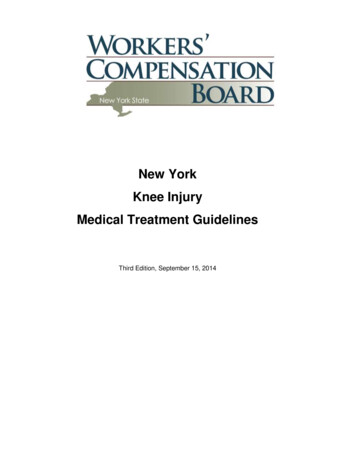
Transcription
New YorkKnee InjuryMedical Treatment GuidelinesThird Edition, September 15, 2014
New York State Workers' Compensation BoardNew York Knee Medical Treatment GuidelinesTABLE OF CONTENTSGENERAL GUIDELINE PRINCIPLES . 1MEDICAL CARE . 1RENDERING OF MEDICAL SERVICES . 1POSITIVE PATIENT RESPONSE . 1RE-EVALUATE TREATMENT. 1EDUCATION . 2DIAGNOSTIC TIME FRAMES. 2TREATMENT TIME FRAMES . 2DELAYED RECOVERY . 2ACTIVE INTERVENTIONS . 3ACTIVE THERAPEUTIC EXERCISE PROGRAM . 3DIAGNOSTIC IMAGING AND TESTING PROCEDURES . 3SURGICAL INTERVENTIONS . 4PRE-AUTHORIZATION . 4PERSONALITY/PSYCHOLOGICAL/PSYCHOSOCIAL EVALUATIONS . 4PERSONALITY/PSYCHOLOGICAL/PSYCHOSOCIAL INTERVENTION . 5FUNCTIONAL CAPACITY EVALUATION (FCE) . 5RETURN TO WORK . 6JOB SITE EVALUATION . 6GUIDELINE RECOMMENDATIONS AND MEDICAL EVIDENCE . 7EXPERIMENTAL/INVESTIGATIONAL TREATMENT . 7INJURED WORKERS AS PATIENTS . 7SCOPE OF PRACTICE . 7INTRODUCTION TO KNEE INJURY . 8HISTORY TAKING AND PHYSICAL EXAMINATION . 8History of Present Injury . 8Past History. 8Physical Examination . 9Red Flags . 9Third Edition, September 15, 2014i
New York State Workers' Compensation BoardNew York Knee Medical Treatment GuidelinesRADIOGRAPHIC IMAGING (X-Ray) . 10LABORATORY TESTING . 10FOLLOW-UP DIAGNOSTIC IMAGING AND TESTING PROCEDURES . 11DIAGNOSTIC STUDIES . 12IMAGING STUDIES . 12Magnetic Resonance Imaging (MRI) .12Computed Axial Tomography (CT) .12Lineal Tomography .13Bone Scan (Radioisotope Bone Scanning) .13Other Radionuclide Scanning .13Arthrograms .13Diagnostic Arthroscopy .13OTHER TESTS . 14Electrodiagnostic Testing (EDX) .14Doppler gram .15OTHER PROCEDURES . 15Joint Aspiration . 15SPECIFIC KNEE INJURY DIAGNOSES, TESTING, ANDTREATMENT . 16CHONDRAL DEFECTS (Cartilage or Cartilage and Bone Defects) . 16Description/Definition . 16Mechanism of Injury. 16Specific Physical Findings . 16Diagnostic Testing Procedures . 16Non-Operative Treatment . 16Surgical Indications/Operative Treatment . 16Autologous Chondrocyte Implantation (ACI) Exclusion Criteria. 17Post-Operative Therapy . 17AGGRAVATED OSTEOARTHRITIS . 21Description/Definition .21Third Edition, September 15, 2014ii
New York State Workers' Compensation BoardNew York Knee Medical Treatment GuidelinesMechanism of Injury.21Specific Physical Findings .21Diagnostic Testing Procedures .21Non-Operative Treatment . 22Surgical Indications/Operative Treatment . 22Post-Operative Therapy . 22COLLATERAL LIGAMENT INJURY . 22Description/Definition . 22Mechanism of Injury. 22Specific Physical Findings . 22Diagnostic Testing Procedures . 22Non-Operative Treatment . 23Surgical Indications/Operative Treatment . 23ANTERIOR CRUCIATE LIGAMENT (ACL) INJURY . 23Description/Definition . 23Mechanism of Injury. 23Specific Physical Findings . 23Diagnostic Testing Procedures . 23Non-Operative Treatment . 23Surgical Indications/Operative Treatment . 23Post-Operative Therapy . 24POSTERIOR CRUCIATE LIGAMENT (PCL) INJURY . 25Description/Definition . 25Mechanism of Injury. 25Specific Physical Findings . 25Diagnostic Testing Procedures . 25Non-Operative Treatment . 25Surgical Indications . 25Operative Treatment. 25Post-Operative Therapy . 25MENISCUS INJURY . 25Third Edition, September 15, 2014iii
New York State Workers' Compensation BoardNew York Knee Medical Treatment GuidelinesDescription/Definition . 25Mechanism of Injury. 25Specific Physical Findings . 26Diagnostic Testing Procedures . 26Non-Operative Treatment . 26Surgical Indications/ Operative Treatment Meniscectomy/Meniscus Repairand Meniscal Allograft Transplantation. . 26Post-Operative Therapy . 26MENISCAL ALLOGRAFT TRANSPLANTATION EXCLUSION CRITERIA . 29PATELLAR SUBLUXATION . 29Description/Definition . 29Mechanism of Injury. 29Specific Physical Findings . 30Diagnostic Testing Procedures . 30Non-Operative Treatment . 30Surgical Indications . 30Operative Treatment. 30Post-Operative Therapy . 30RETROPATELLAR PAIN SYNDROME (CHONDROMALACIA PATELLA) . 30Description/Definition . 30Mechanism of Injury.31Specific Physical Findings .31Diagnostic Testing Procedures .31Non-Operative Treatment .31Surgical Indications .31Operative Treatment.31Post-Operative Therapy . 32TENDINITIS/TENOSYNOVITIS . 33Description/Definition . 33Mechanism of Injury. 33Specific Physical Findings . 34Third Edition, September 15, 2014iv
New York State Workers' Compensation BoardNew York Knee Medical Treatment GuidelinesDiagnostic Testing Procedures . 34Non-Operative Treatment . 34Surgical Indications . 34Operative Treatment. 34Post-Operative Therapy . 34BURSITIS . 34Description/Definition . 34Mechanism of Injury. 34Specific Physical Findings . 34Diagnostic Testing Procedures . 35Non-Operative Treatment . 35Surgical Indications . 35Operative Treatment. 35Post-Operative Therapy . 35THERAPEUTIC PROCEDURES: NON-OPERATIVE . 35ACUPUNCTURE . 36BIOFEEDBACK . 37INJECTIONS: THERAPEUTIC . 37Soft Tissue and Joint Injections . 37Trigger Point Injections . 37Prolotherapy (also known as sclerotherapy) . 37Protein Rich Plasma (PRP) . 37Intra-Capsular Acid Salts. 38MEDICATIONS . 38Acetaminophen . 38Compound Medications. 39Minor Tranquilizer/Muscle Relaxants . 39Narcotics . 39Nonsteroidal Anti-Inflammatory Drugs (NSAIDs) . 40Topical Drug Delivery . 42Tramadol . 43Third Edition, September 15, 2014v
New York State Workers' Compensation BoardNew York Knee Medical Treatment GuidelinesORTHOTICS AND PROSTHETICS . 45Fabrication/Modification of Orthotics . 45Orthotic/Prosthetic Training . 45Splints or Adaptive Equipment . 45RETURN TO WORK . 46Establishment of Activity Level Restrictions . 46Compliance with Activity Restrictions . 46THERAPY: ACTIVE . 47Activities of Daily Living (ADL). 47Functional Electrical Stimulation. 47Gait Training . 48Neuromuscular Re-education . 48Therapeutic Exercise . 48Wheelchair Management and Propulsion . 49THERAPY: PASSIVE . 49Continuous Passive Movement (CPM) . 50Contrast Baths . 50Electrical Stimulation (Physician or Therapist Applied) . 50Fluidotherapy . 50Infrared Therapy . 51Iontophoresis .51Kinesiotaping, Taping or Strapping . 51Manipulation .51Manual Electrical Stimulation .51Massage, Manual or Mechanical . 52Mobilization (Joint) . 52Mobilization (Soft Tissue) . 52Paraffin Bath . 53Superficial Heat and Cold Therapy . 53Short-wave Diathermy . 53Traction . 53Third Edition, September 15, 2014vi
New York State Workers' Compensation BoardNew York Knee Medical Treatment GuidelinesTranscutaneous Electrical Nerve Stimulation (TENS) . 53Ultrasound . 54Vasopneumatic Devices . 54Whirlpool . 54THERAPY: ONGOING MAINTENANCE CARE . 55THERAPEUTIC PROCEDURES: OPERATIVE . 56KNEE FUSION . 56Description/Definition . 56Diagnostic Testing Procedures . 57Non-Operative Treatment . 57Surgical Indications . 57Operative Treatment. 57Post-Operative Therapy . 57KNEE ARTHOPLASTY . 58AMPUTATION . 59Description/Definition . 59Mechanism of Injury. 59Specific Physical Findings . 59Diagnostic Testing Procedures . 59Non-Operative Treatment . 59Surgical Indications . 59Operative Treatment. 59Post-Operative Therapy . 59MANIPULATION UNDER ANESTHESIA (MUA) . 59Description/Definition . 59Mechanism of Injury. 59Specific Physical Findings . 60Diagnostic Testing Procedures . 60Non-Operative Treatment . 60Surgical Indications . 60Operative Treatment. 60Third Edition, September 15, 2014vii
New York State Workers' Compensation BoardNew York Knee Medical Treatment GuidelinesPost-Operative Therapy . 60BURSECTOMY . 60Description/Definition . 60Mechanism of Injury. 60Specific Physical Findings . 60Diagnostic Testing Procedures . 60Non-Operative Treatment . 61Surgical Indications . 61Operative Treatment. 61Post-Operative Therapy . 61OSTEOTOMY . 61Description/Definition . 61Mechanism of Injury. 61Specific Physical Findings . 61Diagnostic Testing Procedures . 61Non-Operative Treatment . 61Surgical Indications . 61Operative Treatment. 62Post-Operative Therapy . 62HARDWARE REMOVAL . 62Description/Definition . 62Mechanism of Injury. 62Specific Physical Findings . 62Diagnostic Testing Procedures . 62Non-Operative Treatment . 62Surgical Indications . 62Operative Treatment. 62Post-Operative Therapy . 62RELEASE OF CONTRACTURE . 63Description/Definition . 63Mechanism of Injury. 63Third Edition, September 15, 2014viii
New York State Workers' Compensation BoardNew York Knee Medical Treatment GuidelinesSpecific Physical Findings . 63Diagnostic Testing Procedures . 63Non-Operative Treatment . 63Surgical Indications . 63Operative Treatment. 63Post-Operative Therapy . 63MENISCECTOMY . 63Description/Definition . 63Evaluation and Management. 63LIGAMENT REPAIR. 64Description/Definition . 64Evaluation and Management. 64INDEX. 66Third Edition, September 15, 2014ix
New York State Workers' Compensation BoardNew York Knee Medical Treatment GuidelinesGENERAL GUIDELINE PRINCIPLESThe principles summarized in this section are key to the intended application of theNew York State Medical Treatment Guidelines (MTG).Medical CareMEDICAL CAREMedical care and treatment required as a result of a work-related injuryshould be focused on restoring functional ability required to meet thepatient’s daily and work activities and return to work, while striving to restorethe patient’s health to its pre-injury status in so far as is feasible.RENDERING OF MEDICAL SERVICESAny medical provider rendering services to a workers compensation patientmust utilize the Treatment Guidelines as provided for with respect to all workrelated injuries and/or illnesses.POSITIVE PATIENT RESPONSEPositive results are defined primarily as functional gains which can beobjectively measured. Objective functional gains include, but are not limitedto, positional tolerances, range of motion, strength, endurance, activities ofdaily living (ADL), cognition, psychological behavior, and efficiency/velocitymeasures which can be quantified. Subjective reports of pain and functionshould be considered and given relative weight when the pain has anatomicand physiologic correlation.RE-EVALUATE TREATMENTIf a given treatment or modality is not producing positive results, the providershould either modify or discontinue the treatment regime. The providershould evaluate the efficacy of the treatment or modality 2 to 3 weeks after theinitial visit and 3 to 4 weeks thereafter. Recognizing that treatment failure isat times attributable to an incorrect diagnosis should prompt the clinician toreconsider the diagnosis in the event of an unexpected poor response to anotherwise rational intervention.Third Edition, September 15, 20141
New York State Workers' Compensation BoardNew York Knee Medical Treatment GuidelinesEducationEDUCATIONEducation of the patient and family, as well as the employ
THERAPY: ACTIVE . Activities of Daily Living (ADL) . 47 Functional Electrical Stimulation . otherwise rational intervention. New York State Workers' Compensation Board New York Knee Medical T
